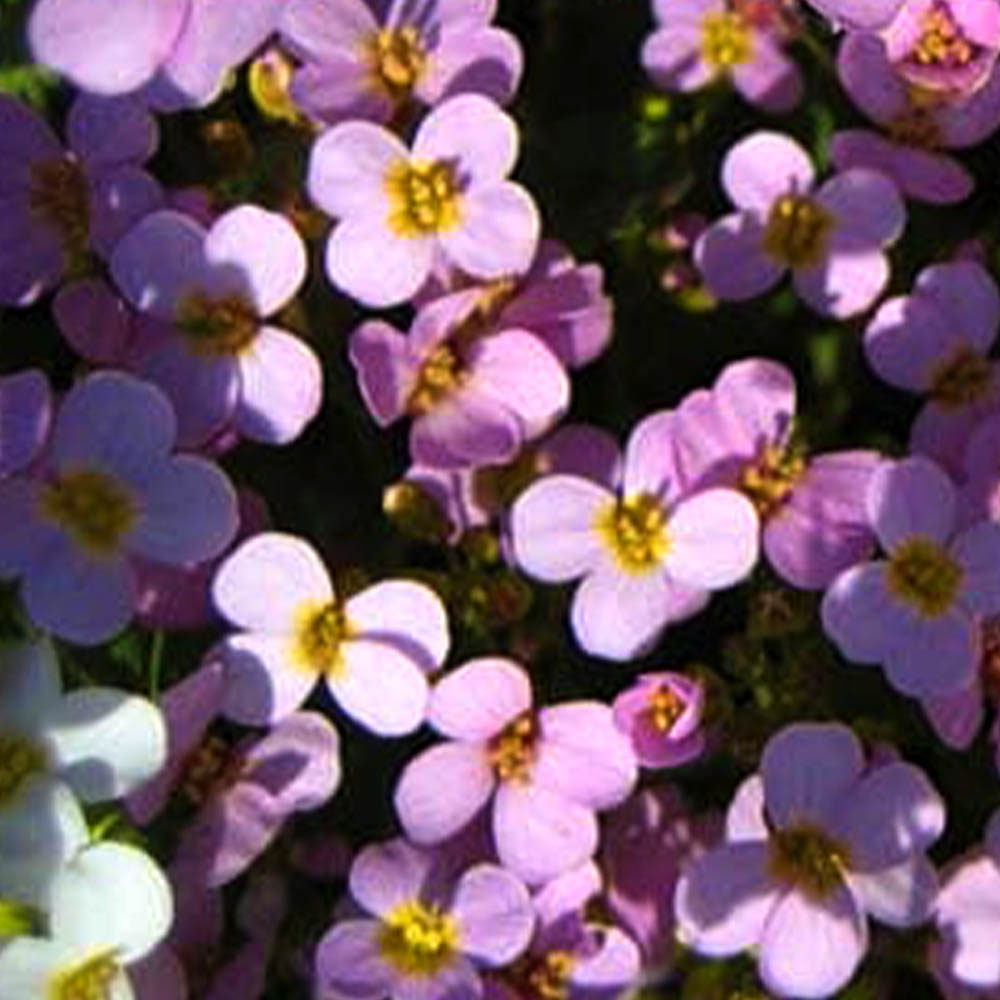-
 9,90 € × 1×€9.9
9,90 € × 1×€9.9
Customer matched zone "Locations not covered by your other zones"
“Arabis alpina Grandiflora Rosea” has been added to your cart. View cart
Arabis alpina Grandiflora Rosea
[Sold by 3]
A charming ground cover with lovely pink flowers for rock gardens in the shade.
Rated 0 out of 5
0 customer reviews9,90 €
Only 200 item(s) left in stock!
SKU: pda514
Category: Balcony-Friendly, Bees and Butterflies, Evergreen, Frost Hardy, Ground Cover, Rewild, Self-Seeding Annual

Arabis alpina Grandiflora Rosea
9,90 €
Only 200 item(s) left in stock!
Arabis alpina subsp caucasica Grandiflora Rosea is a variety of the alpine rock cress, producing a dense carpet of bright green foliage that is covered in charming pink flowers in the spring.
It has small, grey-green leaves and clusters of white, four-petaled flowers typical of the mustard family.
This cultivar is distinguished from the wild type by its larger flower clusters and distinctive rose-pink coloration – a distinction from the usual pure white blooms of the species.
Appreciated for its compact habit, profuse early spring flowering, and ability to thrive in poor, well-drained soils typical of alpine environments.
The plant remains a small, hardy perennial about ten to twenty centimeters tall, evergreen or semi-evergreen depending on climate, and capable of spreading slowly by short shoots.
👨🌾GARDENING TIPS👨🌾: Arabis alpina Grandiflora Rosea
- Not extremely drought tolerant (though more tolerant than Arabis alpina) and it is a prolific self-seeder
It tolerates poor, gritty soil, as long as it stays moist but not waterlogged.
It thrives in both sunny and shaded locations > too much sun will cause the leaves to die back so make sure it gets some afternoon shade
- Looks great with Phlox mousse “Candy Stripes” (Kimono)‘, Achilléa sibirica var. camtschatica Love Parade, Allium montanum, Gypsophila cerastioides
Learn more about gardening with Alpine rock cress:
The Tale & The Botany: Arabis alpina Grandiflora Rosea
A perennial herb belonging to the family Brassicaceae – often described as ‘the mustard family’.
It was collected and described by botanists exploring the alpine regions of Europe as early as the eighteenth century and entered horticulture soon afterward as an ornamental species valued for early spring flowering and resilience in rock gardens.
The cultivar ‘Grandiflora Rosea’ appeared later, probably in the late nineteenth or early twentieth century, during the height of interest in alpine plants among European gardeners – especially during the Victorian and Edwardian eras.
It is thought to have originated in continental Europe, possibly from selections made in alpine nurseries in Germany, France, or the United Kingdom.
The cultivar is thought to have been selected from naturally occurring color variants of A. alpina var. caucasica, which was sometimes used in breeding.
In any case, by the early twentieth century, Arabis alpina Grandiflora Rosea was regularly listed in horticultural catalogues and grown widely in rock gardens throughout Europe.
Naming confusion:
Taxonomically, this cultivar is a subspecies of A. alpina, meaning it shares most characteristics with the European alpine species but has distinct traits.
It is not native to Europe but is native to the Caucasus and nearby regions, bridging the gap between A. alpina (Europe) and A. caucasica (Caucasus proper).
The morphology is slightly different: slightly larger flowers, denser mats, and often more robust in milder climates than typical alpine populations.
In horticulture, plants labeled as “Arabis caucasica” are often actually A. alpina subsp. caucasica, which explains the naming confusion.
Floral Morphology
Each flower bears four sepals and four petals, arranged in a cross shape — a hallmark of cruciferous plants.
The petals are usually white, occasionally tinged with pink in certain cultivars, and are spoon-shaped with a narrow claw and a broader, rounded blade.
Flowers are borne in loose racemes held above the foliage, opening progressively from the bottom upward in early spring.
They are upright to slightly spreading, never nodding, and each is about 1–1.5 cm across.
The foliage consists of basal rosettes of grey-green, slightly hairy leaves, while the stem leaves are smaller, alternate, and often clasp the stem.
Reproductive Biology
Arabis alpina reproduces both sexually by seed and vegetatively through short creeping shoots that root at the nodes.
It is a self-compatible species, meaning it can set seed without cross-pollination, but in natural and garden conditions it is commonly cross-pollinated by insects that transfer pollen between flowers.
It readily self-seeds, often forming small colonies if conditions are suitable, though seedlings may vary slightly from the parent plant, especially in cultivated varieties.
Regular deadheading after flowering helps to prolong blooming and prevents excessive self-sowing, keeping plantings neat.
While technically a perennial, Arabis alpina behaves as a short-lived perennial in many gardens, often persisting for three to four years before declining, though it renews itself readily from seed.
Ecology
In the wild, Arabis alpina is a low, mat-forming perennial adapted to rocky, well-drained habitats at high elevations.
Other names
Alpine Rock-cress
Arabette du Caucase
Corbeille d’Argent
Origin
Caucases
| Weight | 1 kg |
|---|---|
| Flower Color | 🩷 Pink |
| Flowering | February, March, April, May, June |
| Soil | Cool, Poor, Well-Draining, Rocky/Well-Draining |
| Exposure | Half Sun/Half Shade |
| Frost Tolerance | -20°C to -25°C |
| Size | 0.25m H x 0.3m W |
Reviews
0
Rated 0 out of 5
0 customer reviews5
0
4
0
3
0
2
0
1
0
Only logged in customers who have purchased this product may leave a review.
You may also like…
Phlox subulata Candy Stripes
A pink and white striped carpet of flowers
A pink and white striped carpet of flowers
Rated 0 out of 5
Gypsophila cerastiodes
A cushion of mouse ears and delicate white flowers
A cushion of mouse ears and delicate white flowers
Rated 0 out of 5
Related Products
Euphorbia cyparissias Clarice Howard
A Euphorbia that resembles a soft little cyprus tree
A Euphorbia that resembles a soft little cyprus tree
Rated 0 out of 5
Kalanchoe daigremontiana
A toothy succulent from Madagascar, known as the Mother of Thousands.
A toothy succulent from Madagascar, known as the Mother of Thousands.
Rated 0 out of 5
Hellebore argutifolius
Winter flowering perennial with marbled blue-green leaves
Winter flowering perennial with marbled blue-green leaves
Rated 0 out of 5
Echinacea purpurea
A perennial with purple flowers all summer long
A perennial with purple flowers all summer long
Rated 0 out of 5
Delosperma cooperi
A dwarf perennial known for its vermillion colored flowers
A dwarf perennial known for its vermillion colored flowers
Rated 0 out of 5
Glechoma hederacea
A sweet smelling ground cover, producing little blue flowers all summer long.
A sweet smelling ground cover, producing little blue flowers all summer long.
Rated 0 out of 5
Tradescantia Blushing Bride
Gorgeous blushes of pink and white that appear in the coldest nights.
Gorgeous blushes of pink and white that appear in the coldest nights.
Rated 0 out of 5
Mentha x piperita ‘Chartreuse’
A spicy mint, known for its use in the production of liqueurs and herbal teas.
A spicy mint, known for its use in the production of liqueurs and herbal teas.
Rated 0 out of 5
Cerastium tomentosum var. columnae
A grey-green spreading ground cover from the mountains.
A grey-green spreading ground cover from the mountains.
Rated 0 out of 5
Melissa officinalis
A perennial plant in the mint family that is adored by bees, royal families and tea drinkers.
A perennial plant in the mint family that is adored by bees, royal families and tea drinkers.
Rated 0 out of 5
Sedum album
A low, multi-color ground cover.
A low, multi-color ground cover.
Rated 0 out of 5
Stachys byzantina
Silky white-grey leaves and tall striking flowers
Silky white-grey leaves and tall striking flowers
Rated 0 out of 5
Tanacetum densum subsp amani
A shrublet composed of soft, finely divided silvery gray-white leaves.
A shrublet composed of soft, finely divided silvery gray-white leaves.
Rated 0 out of 5
Vinca minor
Looping elegance and ability to form a low flowering ground cover
Looping elegance and ability to form a low flowering ground cover
Rated 0 out of 5
Trachelospermum asiaticum ‘Ogon Nishiki’
Jasmine with colorful foliage and lovely white flowers in summer
Jasmine with colorful foliage and lovely white flowers in summer
Rated 0 out of 5
Artemisia Valerie Finnis
A semi-evergreen, aromatic variation on the theme of Artemisia.
A semi-evergreen, aromatic variation on the theme of Artemisia.
Rated 0 out of 5
Euphorbia myrsinites
Known for its draping form of silver-gray foliage and radiant blooms.
Known for its draping form of silver-gray foliage and radiant blooms.
Rated 0 out of 5
Erigeron kavinskianus
A daisy-like carpet of flowers
A daisy-like carpet of flowers
Rated 0 out of 5
recent view product
Sempervivum arachnoideum x tectorum
Combining the webbed aesthetic of S. arachnoideum with the larger, more robust nature of S. tectorum.
Combining the webbed aesthetic of S. arachnoideum with the larger, more robust nature of S. tectorum.
Rated 0 out of 5
Drought tolerant perennials for 2m2
Collection de vivaces rose-lilas pour un jardin sec de 2m²
Collection de vivaces rose-lilas pour un jardin sec de 2m²
Rated 0 out of 5
Rumex sanguineus
A striking perennial vegetable, known for its tangy spinach taste
A striking perennial vegetable, known for its tangy spinach taste
Rated 0 out of 5
Campanula porscharskyana Lisduggan Variety
A lovely wild ground cover with star shaped lavender flowers
A lovely wild ground cover with star shaped lavender flowers
Rated 0 out of 5
Galium odoratum
A fragrant ground cover with a unique shape
A fragrant ground cover with a unique shape
Rated 0 out of 5


















































There are no reviews yet.